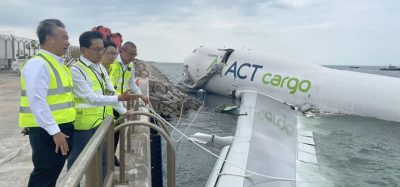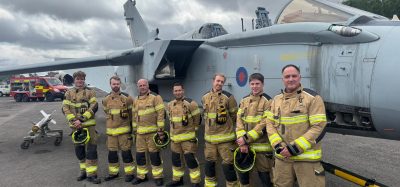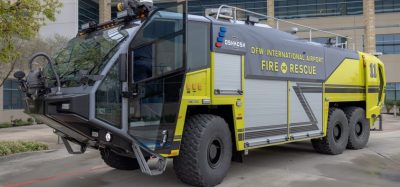ARFF & Recovery: World class fire safety in Papua New Guinea
Posted: 19 December 2013 | Jack Kreckie, ARFF Consultant, ARFF Professional Services LLC | 3 comments
Establishing a world-class aircraft rescue and firefighting department is no mean feat. Renowned ARFF Consultant Jack Kreckie documents the development of an aircraft rescue and firefighting programme in Papua New Guinea…
Establishing a world-class aircraft rescue and firefighting department is no mean feat. Renowned ARFF Consultant Jack Kreckie documents the development of an aircraft rescue and firefighting programme in Papua New Guinea…
Papua New Guinea (PNG), an island country in the western Pacific, is a spectacular place with a wealth of untapped natural resources and endearing people. Covered with a lush, dense tropical rainforest, this naturally pristine country is like nowhere else that I’ve been. This article provides a glimpse into the vision of a joint venture to develop some of these resources safely and responsibly. The complexity and scale of the project challenges some of the biggest companies of the world. The development of the aircraft rescue and firefighting program to support the airfield is a small but critical milestone in the project.
The project
The Komo Airfield was built to support the Papua New Guinea Liquefied Natural Gas (PNG LNG) Project; a gas development project operated by Esso Highlands Limited. The airfield was required to assist with the delivery of large pieces of equipment required for construction of the Hides Gas Conditioning Plant. Air support was needed in addition to road transportation of materials and equipment.
Join our free webinar: Revolutionising India’s travel experience through the Digi Yatra biometric programme.
Air travel is booming, and airports worldwide need to move passengers faster and more efficiently. Join the Digi Yatra Foundation and IDEMIA to discover how this groundbreaking initiative has already enabled over 60 million seamless domestic journeys using biometric identity management.
Date: 16 Dec | Time: 09:00 GMT
rEGISTER NOW TO SECURE YOUR SPOT
Can’t attend live? No worries – register to receive the recording post-event.
Measuring 3.2km in length and 45m wide, the runway at Komo Airfield is the longest in PNG. It was designed and built to support the Antonov 124 cargo aircraft; one of the world’s largest commercial aircrafts.
Safety infrastructure
While Komo Airfield was under construction, aviation planners were simultaneously designing the safety infrastructure necessary to conduct flight operations in the remote area. The Civil Aviation Safety Authority (CASA) of Papua New Guinea regulates aviation operations for aerodromes.
Hostile Environment Services (HES), based in Australia, was tasked with building a worldclass Aircraft Rescue and Fire Fighting (ARFF) department at Komo Airfield. HES is a wellknown emergency services provider which specialises in remote sites in challenging environments. On 18 October 2013, HES became part of Falck; a Scandinavian company which provides safety, emergency response and recovery in over 36 companies.
The airfield needed to be self-sufficient during emergencies, as there are no mutual aid resources located near the camp.
HES recruited a Chief of Global Aviation Fire Protection to oversee the development of this and other aviation-related fire protection projects. This position was tasked to develop personnel guidelines, training programmes and procedures to comply with CASA standards and the Komo Airfield Certification Manual and to handle recruitment.
The Duty Fire Officers (DFOs) needed to be well qualified and experienced to train, mentor and lead local Papua New Guinean staff to a world-class level of qualification and proficiency.
The Fire Chief and two DFOs arrived on site in late December 2012 to prepare for the arrival of firefighters. At that time, the fire station was nearly ready for occupancy and support equipment was on site. The response vehicles included a new Oshkosh Striker 1500 and an E-One Titan 3000. These trucks, along with a command vehicle, comprise the response vehicle fleet for Komo Airfield ARFF.
The recruitment of staff, procurement of equipment, development of training programmes and procedures were launched and the ARFF crew arrived on site in January 2013. Firefighters were recruited based on the PNG standard for ARFF firefighters, with experience as an airport rescue firefighter. Dozens of qualified PNG firefighters applied, seeking this opportunity to raise their level of training, knowledge and proficiency.
The duty shift for Komo ARFF is 28 days on, 28 days off from 6am until 6pm, seven days a week. Each of the firefighters arrived with certification from a PNG ‘Firemanship’ training programme. Upon arrival, the Komo Airfield Fire Academy began the first firefighting class for recruits. Firefighters entered a rigorous 70-day classroom and practical training programme. The training curriculum met the requirements of ICAO, FAA, NFPA 1003 and IFSTA ARFF 5th Edition. Firefighters participated in daily inspections and mandatory physical fitness programmes. Each section of training was accompanied by a written test and proficiency evaluation for each skillset taught.
The locally-recruited firefighters took on the challenge and learnt new skills as part of the in-depth programme. Firefighters conducted bunker gear drills daily which required them to don helmet, hood, boots, bunker pants, bunker coat and gloves in 45 seconds. The evenings after dinner involved study group and more bunker gear drills.
Part of the training included understanding the various cultures of the team – both Papua New Guinean culture and those of the trainers. The sharing and understanding of each other’s backgrounds strengthened the team as a unit.
Logistics
The single most challenging component of building and operating a fire department in a remote area such as PNG is obtaining goods and materials to support the operations. Most equipment was sourced in Australia or the United States. The goods first needed to be manifested by the shipper, packed and prepared for export. Once in PNG, the goods were sent to a customs warehouse for clearance. They were then consolidated into shipments ready for transportation. The distance from Port Moresby, the nation’s primary port of arrival, to Komo is approximately 760km over very rough roads. From Port Moresby most freight was transported to Moro or Tari (located in the Southern Highlands and Hela provinces respectively) on fixed wing charter aircraft. Prior to the runway opening at Komo, these shipments were usually transported the rest of the way to Komo by helicopters which were already providing service to the construction project. Larger shipments often took several trips to arrive in Komo from Port Moresby as space was available. Load and balance had to be calculated for each flight, as well as the priority of the shipments.
Health and safety
PNG lies within a malaria region. Malaria is caused by a parasite called plasmodium, which is transmitted through the bites of infected mosquitoes. In the human body, the parasites multiply in the liver, and then infect red blood cells. Therefore entering a malaria region requires a number of precautions.
The PNG LNG Project treats this disease seriously. Prior to entering the country, people who are considered ‘non-immune’ to malaria are required to complete training in malaria prevention, recognition of symptoms and treatment. Health screening and testing is completed for each person arriving at Komo Airfield. Prophylaxis medication to help protect against infection must be taken and protective long-sleeved, insect repellant shirts and trousers are mandatory for everyone working at the airfield.
Precautions at the camps include an insect control programme and the mandatory use of Deet-based insect repellant. Training events, posters and safety briefings are also utilised to maintain awareness of the risks of malaria and the ways to prevent illness and injuries.
The standard uniform in PNG includes hard-toed boots, hard hats, gloves, safety glasses and hearing protection. All are part of the comprehensive safety plan at Komo Airfield.
Commissioning
The process for commissioning the new fire station, the ARFF vehicles, tools and equipment was ongoing through the initial firefighter training period. However, with the full-time training completed and the arrival of the first Antonov looming, it was all hands on deck to complete the airfield and to ensure that all of the tools, equipment and procedures were fully tested and operational.
An airfield coordination meeting was conducted at 6am each morning. The Komo ARFF DFO would report on the day’s planned activities and harmonise activities with the construction activities. Turret training was combined with FOD removal on the runway. Runway driver training included runway inspections, fence line integrity patrols, and wildlife management. Everyone at Komo was committed to a safe, on-time opening of the airfield.
Prior to formal acceptance and assignment to service, both pieces of fire apparatus needed to be fully inspected, including performance and foam refractometer testing, discharge rates, flushing procedures and speed of re-service.
Komo Airfield ARFF uses a three per cent AFFF Performance Level B firefighting foam concentrate. Minimum reserve capacity required by ICAO/CASA is 200 per cent of the quantity carried on the ARFF vehicles. But due to the remote location of Komo, reorder levels are much higher to allow for the long lead time in delivery.
Tactics and strategy
Emergency preparedness at Komo Airfield calls for a very aggressive fire attack with highly competent firefighters and well-rehearsed tactical plans. The remote highlands of PNG have no mutual aid cadre of fire apparatus nearby to provide assistance. With this understanding, the focus is very concentrated with the following objectives:
1. Rapid response
2. Immediate protection of escape paths
3. Aggressive fire attack on occupied portion of fuselage
4. Rapid extraction of occupants.
Aircraft arrival
All of the construction, preparedness and training were in anticipation of one thing: the commencement of cargo operations using the Antonov aircraft. And when the flight schedule was confirmed, preparations ramped up. The firefighting team had completed their initial training and were anxious to see the operations begin. The first landing of the Antonov 124 at Komo Airfield took place on 3 May 2013. This long-anticipated milestone meant that the hard work preparing for flight arrivals had finally paid off.
Airfield ARFF operations
For Komo ARFF, the arrival of the first Antonov simply kicked-off a new chapter in the mission. The training moved from the classroom to the aircraft. It was time to take all the videos, crash charts and lectures and apply the knowledge on the aircraft.
The ARFF team was provided access to and instruction in each area of the aircraft. All firefighters were fully trained in the cockpit for emergency shut down and pilot extraction.
The Antonov transported equipment for the PNG LNG project in 88 flights. After the completion of those flights in August 2013, ongoing operations at the airfield continued, with Dash 8-100 charter aircraft, L-100 freighters and numerous helicopters using the facility. Komo ARFF is continually on standby, monitoring arrivals, departures and fueling operations.
The firefighters and fire officers at Komo Airfield are some of the finest people that I know. I have deep regard for their commitment, their hard work and the respect and friendship that I feel from each of them. These men not only represent the best in PNG, but I dare to say, ARFF teams worldwide.
Author’s acknowledgement
I have been blessed to be part of this once-in-alifetime opportunity. Although PNG is geographically a world away from my home office, the bonds that I have developed with the PNG people will last a lifetime. I was genuinely touched by the sincerity and heart of these wonderful people. I was in PNG during the Boston Marathon bombings in my home town. I was amazed at the number of Papua New Guineans that approached me in Komo to offer their condolences and ask if my family was safe. I went to PNG to teach and to lead, but instead learned so much about a culture and fell in love with the character of a wonderful people.
Biography
Jack Kreckie is a 35-year veteran of the fire service. He retired from his position of Deputy Fire Chief at Boston Logan International Airport in 2007. His ARFF con – sulting firm, ARFF Professional Services LLC., has provided expertise to a number of high profile customers such as the Federal Aviation Administration, SRA International, Science Applications International Corporation SAIC), multiple airport and municipal fire departments across the United States. Jack has served as an overseas guest lecturer for the Singapore Aviation Academy. He is also a well-known author and speaker. Jack is the Global Chief of Aviation Fire Protection for Hostile Environment Service in Western Australia and serves as Fire Chief for the Komo Airfield ARFF Department in Papua New Guinea. Papua New Guinea PNG occupies the eastern half of the tropical island of New Guinea which it shares with the Indonesian territory of Irian Jaya. It is located north of Australia and west of the Solomon Islands. The centre of the island rises into a wide ridge of mountains called the Highlands. The country possesses one of the planet’s largest remaining tropical rainforests, with at least 75 per cent of its original forest cover still standing, occupying vast, biologically rich tracts over 100,000 square miles in total. Its forests provide the habitat for around 200 species of mammals, 20,000 species of plants, 1,500 species of trees, and 750 species of birds; half of which are endemic to the island. It has been estimated that between five and seven per cent of the known species in the world live in PNG. PNG is one of the most culturally diverse countries in the world and according to recent data more than 800 languages are listed for the country. Runway construction in the final stages kreckie iar613_Layout 1 10/12/2013 08:58 Page 4
Join our free webinar: Revolutionising India’s travel experience through the Digi Yatra biometric programme.
Air travel is booming, and airports worldwide need to move passengers faster and more efficiently. Join the Digi Yatra Foundation and IDEMIA to discover how this groundbreaking initiative has already enabled over 60 million seamless domestic journeys using biometric identity management.
Date: 16 Dec | Time: 09:00 GMT
rEGISTER NOW TO SECURE YOUR SPOT
Can’t attend live? No worries – register to receive the recording post-event.

















Well Said. As a Papua New Guinean and on behalf of my Country, I would like to Thank you Mr. Jack Kreckie for putting Papua New Guinea on the Map. Much appreciate it.
Michael Mirihao
To have had such world renowned fire specialist in Papua New Guinea as Chief at Komo is something any PNG citizen would proud of. As an Aviation Fire fighter myself, It is unbelievable that such a gifted person was in my home country imparting training to firefighters and even fell in love with PNG and its people.
I have so much respect and love for Mr Kreckie!
I was the pioneer of 15 local fire fighters recruited for Komo Airfield and I was privileged to work with Jack and the 2 x Mexicans Duty Fire Officers. I really acclaimed the experience and proficiency received from very renowned Fire Chief Jack Kreckie